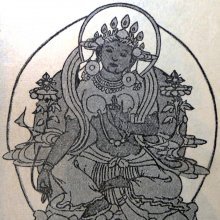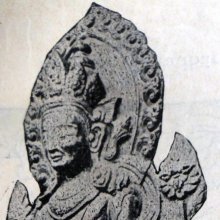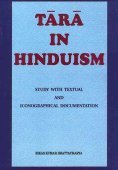Tarini, Tāriṇī, Tariṇī: 9 definitions
Introduction:
Tarini means something in Buddhism, Pali, Hinduism, Sanskrit, Tamil. If you want to know the exact meaning, history, etymology or English translation of this term then check out the descriptions on this page. Add your comment or reference to a book if you want to contribute to this summary article.
Images (photo gallery)
In Hinduism
Shaktism (Shakta philosophy)
Source: Sacred Texts: Hymns to the GoddessTāriṇī (तारिणी) or Tara is the name of a Mahāvidyā.—The Matsyasūkta, Tārārṇava, and Nīla Tantras deal with particulars or Tārā or Tāriṇī, one of the Mahāvidyā, whose bīja is Hrīm Strīm, Hūm (Kurccha), Phat. She is called Nīlasarasvatī, because She playfully gives the power of speech. She is called Tārā on account of her being deliverer or saviour (tārakatvāt). She gives both pleasure (sukha) and liberation (mokṣa). She is called also Ugratārā, because She saves from formidable and horrible calamities. Ṛṣi Vasiṣṭha [Vaśiṣṭha] is said to have cursed this vidyā, and then raised the curse so that siddhi might be gained from Her by japa of the Bīja Hrīm, Strīm, Hūm, Phat, after which She again became glorious.

Shakta (शाक्त, śākta) or Shaktism (śāktism) represents a tradition of Hinduism where the Goddess (Devi) is revered and worshipped. Shakta literature includes a range of scriptures, including various Agamas and Tantras, although its roots may be traced back to the Vedas.
In Buddhism
Tibetan Buddhism (Vajrayana or tantric Buddhism)
Source: archive.org: The Indian Buddhist IconographyTāriṇī (तारिणी) or Tārā is the Śakti, or female counterpart (spiritual consort) of Amoghasiddhi: one of the Dhyāni-Buddhas, according to Vajrayāna or Tantric Buddhism.—Her colour is green; and her symbol is utpala.—According to a Dhyāna found in the Pañcākāra section of the Advayavajrasaṃgraha, [Tārā] belongs to the Karma family to which evidently the Dhyāni Buddha Amoghasiddhi is also associated. The green colour of Tārā also suggest that she is the spiritual consort of Amoghasiddhi of green colour.
Tāriṇī’s form and nature are given in the Advayavajrasaṃgraha:—“In the īśāna corner on the orb of the moon there is Tāriṇī originating from the germ syllable Tāṃ of golden green colour. Her recognition symbol is a green night lotus. She is the embodiment of the element of Air. She belongs to the Karma family and is full of jealousy”.

Tibetan Buddhism includes schools such as Nyingma, Kadampa, Kagyu and Gelug. Their primary canon of literature is divided in two broad categories: The Kangyur, which consists of Buddha’s words, and the Tengyur, which includes commentaries from various sources. Esotericism and tantra techniques (vajrayāna) are collected indepently.
Languages of India and abroad
Sanskrit dictionary
Source: DDSA: The practical Sanskrit-English dictionaryTariṇī (तरिणी).—A boat, ship.
See also (synonyms): taritra, taritrī.
Source: Cologne Digital Sanskrit Dictionaries: Edgerton Buddhist Hybrid Sanskrit DictionaryTāriṇī (तारिणी) or Tārā.—: Sādhanamālā 208.2 (prose), etc.
Source: Cologne Digital Sanskrit Dictionaries: Cappeller Sanskrit-English DictionaryTariṇī (तरिणी).—[feminine] boat, ship.
Source: Cologne Digital Sanskrit Dictionaries: Monier-Williams Sanskrit-English Dictionary1) Tariṇī (तरिणी):—[from tarin > tara] f. [varia lectio] for raṇī q.v.
2) Tāriṇī (तारिणी):—[from tāra] a in [compound]
3) [from tārin > tāra] b f. a form of Durgā, [Tantrasāra ii]
4) [v.s. ...] (= rā) Name of a, [Buddhist literature] goddess, [cf. Lexicographers, esp. such as amarasiṃha, halāyudha, hemacandra, etc.]
Source: Cologne Digital Sanskrit Dictionaries: Yates Sanskrit-English DictionaryTāriṇī (तारिणी):—(ṇī) 3. f. A Jaina goddess; a name of Durgā.
Sanskrit, also spelled संस्कृतम् (saṃskṛtam), is an ancient language of India commonly seen as the grandmother of the Indo-European language family (even English!). Closely allied with Prakrit and Pali, Sanskrit is more exhaustive in both grammar and terms and has the most extensive collection of literature in the world, greatly surpassing its sister-languages Greek and Latin.
Kannada-English dictionary
Source: Alar: Kannada-English corpusTāriṇi (ತಾರಿಣಿ):—
1) [noun] she who helps crossing over a river or pass through a formidable, distressing situation.
2) [noun] Durge, the mother-power of the universe.
3) [noun] (Buddh.) name of a goddess.
Kannada is a Dravidian language (as opposed to the Indo-European language family) mainly spoken in the southwestern region of India.
Tamil dictionary
Source: DDSA: University of Madras: Tamil LexiconTāriṇi (தாரிணி) noun < dhāriṇī.
1. Earth; பூமி. தாரிணி பொதிந்த கீர்த்தி [pumi. tharini pothintha kirthi] (இரகுவமிசம் யாகப். [iraguvamisam yagap.] 34).
2. Silk cotton tree; இலவமரம். (இலக்கியச் சொல்லகராதி) [ilavamaram. (ilakkiyas sollagarathi)]
Tamil is an ancient language of India from the Dravidian family spoken by roughly 250 million people mainly in southern India and Sri Lanka.
See also (Relevant definitions)
Starts with: Tarinikalpa, Tarinitantra.
Query error!
Full-text (+57): Dharini, Tarinitantra, Jamintarini, Bhutadharini, Cihnadharini, Dhakkari, Vishvadharini, Lohatarini, Vasudharini, Lingadharini, Keshadharini, Lokadharini, Manidharini, Karnadharini, Dipikadharini, Tarinikalpa, Shivadharini, Durgatarini, Ashtatarini, Lohacarini.
Relevant text
Search found 37 books and stories containing Tarini, Darini, Dharini, Tāriṇī, Tariṇī, Tāriṇi, Thaarini, Tharini; (plurals include: Tarinis, Darinis, Dharinis, Tāriṇīs, Tariṇīs, Tāriṇis, Thaarinis, Tharinis). You can also click to the full overview containing English textual excerpts. Below are direct links for the most relevant articles:
Kamashastra and Classical Sanskrit literature (study) (by Vishwanath K. Hampiholi)
Chapter 4.2 - Regarding the conduct of the elder wife < [Chapter 5 - Kamasutra part 4 (Bharya-adhikarana )—Critical study]
Chapter 1.4 - The life of Citizens and Educated persons < [Chapter 2 - Kamasutra part 1 (Sadharana-adhikarana)—Critical study]
World Journal of Pharmaceutical Research
Zolpidem tartrate solid dispersion sublingual tablet evaluation < [2017: Volume 6, August issue 8]
A critical review on kala sharir w.s.r to mamsadhara kala < [2021: Volume 10, July issue 8]
Concept of mukhdushika in ayurveda < [2021: Volume 10, September issue 11]
Rig Veda (translation and commentary) (by H. H. Wilson)
Rig Veda 8.5.6 < [Sukta 5]
Notices of Sanskrit Manuscripts (by Rajendralala Mitra)
Sripura (Archaeological Survey) (by Bikash Chandra Pradhan)
Sasai Maha Vihar (SRP-I) < [Chapter 2 - The Architectural Panorama]
Devi Bhagavata Purana (by Swami Vijñanananda)
Related products


